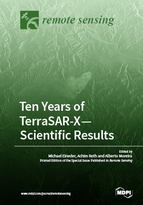Ten Years of TerraSAR-X—Scientific Results
A special issue of Remote Sensing (ISSN 2072-4292).
Deadline for manuscript submissions: closed (30 April 2018) | Viewed by 177306
Special Issue Editors
Interests: SAR interferometry; InSAR; geodetic SAR; digital elevation models; SAR applications
Interests: SAR applications; digital elevation models
Interests: SAR technology; SAR missions; SAR applications
Special Issues, Collections and Topics in MDPI journals
Special Issue Information
Dear Colleagues,
In the year 2017 we are looking back on 10 years of reliable TerraSAR-X operations. This X-band synthetic aperture radar (SAR) satellite offered for the first time very-high-resolution radar imagery from space with extreme geometric accuracy on the centimeter level, outstanding interferometric capabilities, different polarizations, and experimental imaging modes such as an along-track interferometry mode (ATI), a quad-pol mode, and recently a starring spotlight and a wide ScanSAR mode.
TerraSAR-X was launched in the scope of a public–private partnership between the German Aerospace Center (DLR) and Airbus Defence and Space. While DLR is responsible for data reception and archive, data processing and calibration, as well as for promoting and coordinating research with the data, Airbus has developed the satellites and takes over the commercial data exploitation. In 2010, TerraSAR-X was followed by its sister satellite. When both are operated in bi-static interferometric configuration, they form the TanDEM-X mission.
Thanks to its high resolution and the precise revisit geometry, TerraSAR-X opened new capabilities for many applications. For example, the monitoring of highly structured urban areas was significantly improved even down to the level of single buildings and infrastructure such as bridges. The position of individual scatterers can be determined with sub-meter precision by interferometric and tomographic methods. Repeat-pass interferometry revealed relative deformation even within buildings or infrastructure.
In ocean applications, TerraSAR-X shows details of wave patterns unresolved so far. Small ships can be detected, and even their type classified. In the cryosphere, glacier velocities could be determined all year round by feature tracking thanks to the high resolution and the geometric accuracy. Additionally, the understanding of small-scale landslides or the dynamics of volcanos benefit from the high spatial and temporal resolution of an X-band system.
In the last 10 years, the geometric accuracy has been pushed to the maximum by means of novel correction methods and calibration procedures. Today, TerraSAR-X has an unprecedented geometric accuracy, capable of pin-pointing objects in 3D space within a 5-cm cube, making it a most precise geodetic imaging sensor in space.
In this call for a special issue “Ten Years of TerraSAR-X – Scientific Results”, we expect contributions on new scientific results covering methods and applications as well as overview papers on topics such as
- high-resolution deformation measurements,
- urban tomography,
- urban mapping applications,
- geodetic applications
- cryosphere applications,
- agriculture and forestry,
- ocean applications,
- and others.
The submission of overview papers should be coordinated with the editors to avoid overlapping and conflicts.
We especially welcome papers that exploit the 10-year continuity of data and the worldwide coverage.
Note that this Special Issue will not address the TanDEM-X mission (i.e. methods and applications that are focused on applications related to digital elevation models and use bi-static or pursuit-monostatic data). We plan to coordinate another special issue on TanDEM-X soon.
Authors are required to check and follow the specific instructions to authors at https://www.mdpi.com/journal/remotesensing/instructions
Prof. Dr. Michael Eineder
Mr. Achim Roth
Prof. Dr. Alberto Moreira
Guest Editors
Manuscript Submission Information
Manuscripts should be submitted online at www.mdpi.com by registering and logging in to this website. Once you are registered, click here to go to the submission form. Manuscripts can be submitted until the deadline. All submissions that pass pre-check are peer-reviewed. Accepted papers will be published continuously in the journal (as soon as accepted) and will be listed together on the special issue website. Research articles, review articles as well as short communications are invited. For planned papers, a title and short abstract (about 100 words) can be sent to the Editorial Office for announcement on this website.
Submitted manuscripts should not have been published previously, nor be under consideration for publication elsewhere (except conference proceedings papers). All manuscripts are thoroughly refereed through a single-blind peer-review process. A guide for authors and other relevant information for submission of manuscripts is available on the Instructions for Authors page. Remote Sensing is an international peer-reviewed open access semimonthly journal published by MDPI.
Please visit the Instructions for Authors page before submitting a manuscript. The Article Processing Charge (APC) for publication in this open access journal is 2700 CHF (Swiss Francs). Submitted papers should be well formatted and use good English. Authors may use MDPI's English editing service prior to publication or during author revisions.







